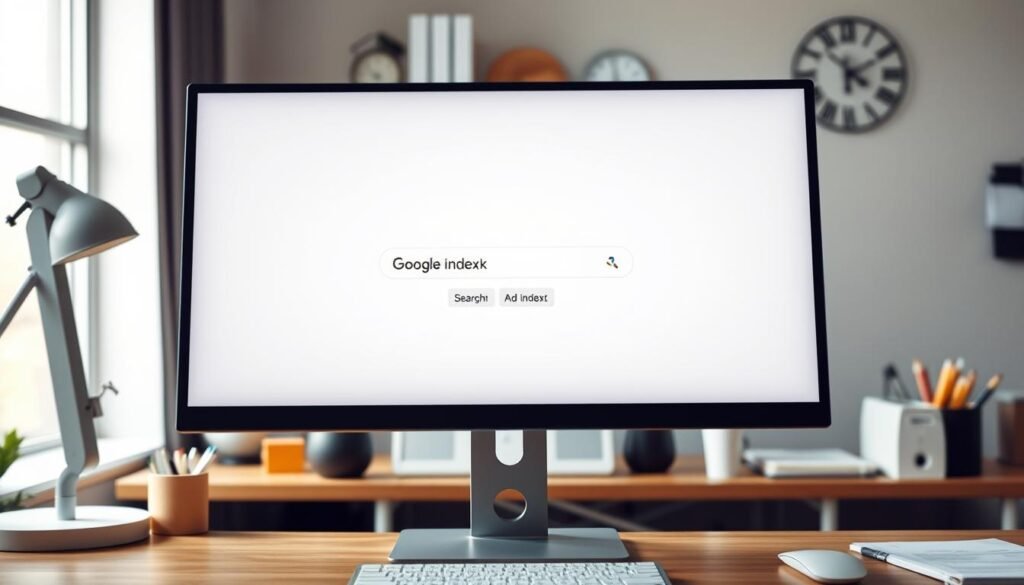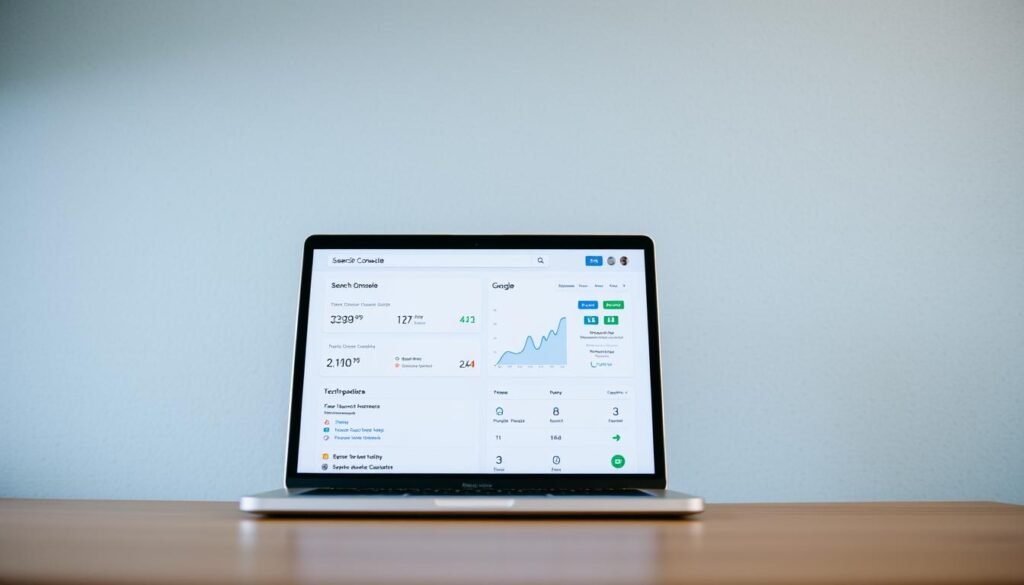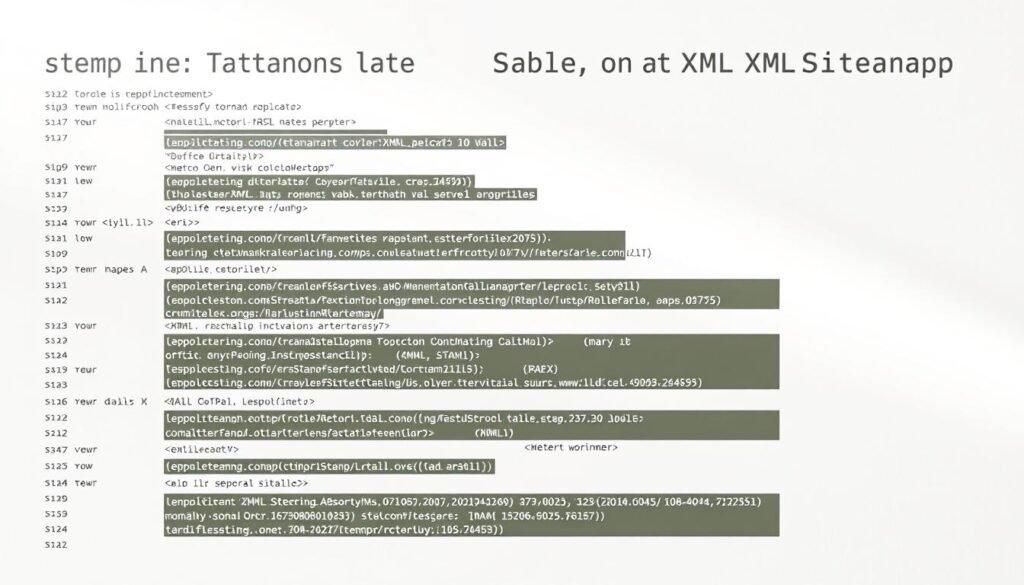Physical Address
304 North Cardinal St.
Dorchester Center, MA 02124
Physical Address
304 North Cardinal St.
Dorchester Center, MA 02124

Are you struggling to get your website to appear in search results? Having your site properly indexed by search engines is crucial for online visibility. Without it, your content remains invisible, no matter how valuable it is.
Many website owners face indexing issues, preventing their page from showing up in search results. I’ll guide you through a 5-step process to get your site fully crawled and indexed, improving your online presence.
As search engines become more selective, proper optimization is key. I’ll cover the relationship between crawling, indexing, and ranking, and highlight common symptoms of indexing problems.
Understanding the Google Index and its significance is vital for any website owner looking to increase their online presence. The Google Index is a massive database where Google stores information about web pages. For a website to appear in search results, it must be crawled by Googlebot and then indexed.
The Google Index is essentially a huge library containing information about billions of web pages. When you search for something on Google, it doesn’t search the live web; instead, it looks through its index to provide relevant results. The index includes various types of content, such as text, images, and videos.
To be included in this index, a website must first be crawled by Googlebot, Google’s web crawling software. Googlebot systematically browses the web, following links from one page to another to discover new or updated content. Once a page is crawled, Google analyzes its content to determine its relevance and quality.
The process of crawling and indexing is complex and involves several steps. Here’s a simplified overview:
While Google’s algorithms control the indexing process, there are steps you can take to influence it. For instance, ensuring your website is mobile-friendly and has a clear structure can improve its crawlability.
| Process | Description | Influence |
|---|---|---|
| Crawling | Googlebot discovers new or updated pages. | Ensure clear website structure and internal linking. |
| Indexing | Google analyzes content and adds it to the index. | Focus on high-quality, relevant content. |
| Ranking | Google retrieves relevant pages and ranks them. | Optimize with relevant keywords and meta tags. |

Verifying if your website is included in Google’s index is a fundamental step in search engine optimization. To do this, you can use several methods, each providing valuable insights into your site’s visibility on Google.
One simple way to check if Google has indexed your website is by using the site: search operator. By typing site:yourdomain.com in the Google search bar, you’ll see a list of pages from your site that are currently indexed. This method gives you a quick overview of your site’s presence on Google.
For a more detailed analysis, use Google Search Console (GSC). GSC provides comprehensive information about your site’s indexing status, including the number of indexed pages and any crawling errors. To check the indexing status, navigate to the “Indexing” section in GSC, where you’ll find insights into how Google is crawling and indexing your site.
To check the status of a specific URL, use the URL inspection tool in GSC. Start by entering the URL in the search bar at the top. If you see the “URL is on Google” status, it means Google has crawled and indexed it. You can check the details to see when it was last crawled and also get other helpful information. If you see the “URL is not on Google” status, you’ll need to address the issue preventing it from being indexed.
| Method | Description | Usefulness |
|---|---|---|
| site: Search Operator | Quick check of indexed pages | High |
| Google Search Console | Detailed indexing status and crawling errors | Very High |
| URL Inspection Tool | Inspect individual URLs for indexing status | Very High |
As John Mueller, a Google Search Advocate, once said,
“Making sure that your content is indexed is one of the most important things you can do for your website’s visibility.”
By using these methods, you can ensure that your website is properly indexed by Google, improving your online presence.

Understanding why Google won’t index your site is crucial for improving your website’s visibility. Several factors can hinder the indexing process, ranging from technical issues to content quality problems. In this section, we’ll explore the common reasons behind Google’s indexing challenges.
Technical barriers can significantly impede Google’s ability to crawl and index your site. One common issue is the improper use of meta tags, such as noindex or nofollow, which can inadvertently block Google’s crawl bots. Additionally, a poorly configured robots.txt file can restrict Google’s access to certain pages or your entire site. Ensuring that your site’s technical infrastructure is sound is vital for facilitating a smooth Google crawl process.
Another technical issue is related to internal links. Internal linking helps crawlers discover new content on your site. If your internal links contain the nofollow attribute, Google may choose to ignore the target page, potentially preventing it from being indexed. It’s essential to review your internal linking strategy to ensure that important pages are being linked to effectively.
Click here to get a free, no-obligation site audit and action plan.
Content quality plays a significant role in Google’s decision to index your site’s pages. Thin or duplicate content can lead to indexing issues, as Google prioritizes high-quality, unique content. If your site contains a significant amount of low-quality or duplicated content, it may be viewed as less authoritative, making it harder for your important pages to get indexed.
Moreover, the overall quality and relevance of your content can impact how Google perceives your site. Ensuring that your content is well-researched, engaging, and provides value to users is crucial. As Google’s algorithms continue to evolve, the emphasis on high-quality content remains a constant factor in determining indexing eligibility.
A well-organized site structure is essential for facilitating Google’s crawl and indexing processes. Issues such as orphaned pages (pages with no internal links pointing to them) can make it difficult for Google to discover and index your content. Additionally, if certain pages require more than three clicks to reach from the homepage, they may be less likely to be crawled and indexed effectively.
To address these issues, it’s crucial to implement a logical and flat site architecture, making it easier for both users and search engines to navigate your site. By doing so, you can improve the visibility of your important pages and enhance your site’s overall crawlability.

Ensuring your website is accessible to Google is the first step towards getting it fully indexed. This involves checking several technical aspects of your site to ensure that Google’s crawlers can discover and index your content without any issues.
Your robots.txt file is a crucial file that instructs Google’s crawlers on which parts of your site to crawl or not to crawl. To check your robots.txt file, navigate to yoursitename.com/robots.txt. Ensure that you’re not inadvertently blocking Google from crawling important pages. For instance, directives like User-agent: * Disallow: / can prevent Google from accessing your site. If you find such directives, consider removing or modifying them to allow Google to crawl your site.
It’s also a good practice to test your robots.txt file using Google Search Console’s robots.txt tester tool. This tool helps you identify and fix any issues that might be preventing Google from crawling your site.
Noindex tags are HTML meta tags that instruct search engines not to index a particular page. If a page contains a noindex tag, Google will not index it, even if it’s crawled. To remove noindex tags, inspect the HTML of your pages, specifically looking for <meta name="robots" content="noindex"> or similar directives. Remove these tags from pages you want Google to index.

Google Search Console can also help identify pages with noindex tags. Navigate to the “Coverage” report and look for “Excluded by ‘noindex’ tag” to find affected pages.
Canonical tags are used to specify the preferred version of a page when there are duplicate versions. However, if a canonical tag points to another URL, Google may not index the page in question. To fix this, use Google Search Console’s “Pages” report to identify pages with canonical tag issues. Scroll down to “Why pages aren’t indexed” and click on “Alternate page with proper canonical tag.” Remove or correct the canonical tag on pages you want indexed.
For instance, if a page has a canonical tag pointing to itself, it’s correctly indicating that it’s the preferred version. However, if it points to another URL, you may need to adjust it. Ensure that canonical tags are used correctly to avoid indexing issues.
By addressing these technical aspects, you can ensure that your site is accessible to Google and improve its chances of being fully indexed.
To ensure your website is fully crawled and indexed by Google, creating and submitting an XML sitemap is a crucial step. An XML sitemap acts as a roadmap for search engines, helping them understand your site’s structure and content.
An XML sitemap is a file that lists the URLs of your website, along with additional metadata about each URL, such as when it was last updated and how frequently it changes. This information helps search engines like Google discover new content and understand how to prioritize crawling your site.

To create an effective XML sitemap, you should include all the important pages on your site. You can manually create a sitemap or use a tool to generate it automatically. Ensure that your sitemap is updated regularly, especially when you add new content or make significant changes to your site.
Once you’ve created your sitemap, the next step is to submit it to Google Search Console. To do this, navigate to the Sitemaps section in your Google Search Console account, enter your sitemap URL (typically yourdomain.com/sitemap.xml), and hit “Submit.” It may take a couple of days for your sitemap to be processed. When it’s done, you should see the link to your sitemap and a green “Success” status in the report.
Submitting your sitemap can help Google discover all the pages you deem important and speed up the indexing process. Regularly monitoring your sitemap’s performance in Google Search Console is also crucial, as it allows you to check how many URLs were discovered versus indexed and troubleshoot any issues that arise.
By optimizing your internal linking, you can enhance your site’s visibility and ensure that Google indexes your important pages. Internal linking is a crucial aspect of SEO that helps search engines understand your site’s structure and content hierarchy.
Internal links play a vital role in facilitating the crawling and indexing process. They help Google discover new content and understand the relationship between different pages on your site. By linking to new or important pages from high-authority pages, you can significantly improve their chances of being indexed.
Orphaned pages are those that are not linked to from any other page on your site. These pages can be difficult for Google to discover and index. To identify orphaned pages, you can use tools like Google Search Console or third-party SEO audits. Once identified, you can fix these issues by adding relevant internal links to these pages from other high-authority pages on your site.
To maximize the effectiveness of your internal linking, follow these best practices: Use descriptive, keyword-rich anchor text for your internal links to help Google understand the content of the linked page. Create hub pages or pillar content that links to related articles, forming topical clusters that are easier for Google to crawl and understand. Ensure that your internal linking is natural and contextual, providing value to users rather than being forced or artificial.
By implementing these strategies, you can improve your site’s internal linking structure, enhancing its crawlability and indexability. This, in turn, can lead to better visibility in search engine results and improved overall SEO performance.
With Google Search Console, you can proactively request indexing for your pages, helping Google discover your content faster. This step is crucial in ensuring that your site is fully crawled and indexed, especially for new or updated content.
The URL Inspection Tool in Google Search Console allows you to check the indexing status of specific pages and request indexing if necessary. To use this tool, navigate to Google Search Console, select the property you want to inspect, and enter the URL you wish to check. If the page is not indexed, you can request indexing directly from the tool. This feature is particularly useful for new pages or pages that have been significantly updated.
When requesting indexing, follow these best practices to maximize effectiveness:
By strategically requesting indexing through Google Search Console, you can improve the visibility of your pages and expedite the crawling and indexing process.
With your site’s technical aspects in check, it’s time to enhance its overall quality and authority. This step is crucial for improving your site’s visibility on Google and ensuring it gets fully crawled and indexed.
Creating high-quality, engaging content is fundamental to improving your site’s authority. Focus on producing well-researched, original content that provides value to your readers. Ensure that your content is comprehensive, covering all aspects of the topic you’re addressing. By doing so, you’ll not only attract more visitors but also increase your site’s credibility.
To achieve this, consider the following strategies:
Building relevant backlinks from authoritative sites is another effective way to boost your site’s authority. Backlinks act as endorsements of your content, signaling to Google that your site is trustworthy and worthy of crawling and indexing.
To build high-quality backlinks, focus on:
E-E-A-T, which stands for Experience, Expertise, Authoritativeness, and Trustworthiness, is a critical factor in Google’s content evaluation. To enhance your site’s E-E-A-T signals, focus on providing transparent author information, highlighting contributors’ expertise, and collaborating with subject matter experts.
Additionally, ensure that you:
By implementing these strategies, you’ll not only improve your site’s overall quality and authority but also increase its chances of being fully crawled and indexed by Google.
When dealing with Google index issues, understanding the specific status of your pages is crucial. Google Search Console provides valuable insights into how Google interacts with your site, including indexing statuses that can help you identify and fix problems.
The “Crawled – Currently Not Indexed” status indicates that Google has crawled your page but hasn’t indexed it yet. This can happen for several reasons, including duplicate content, low-quality content, or crawl budget limitations. To address this issue, ensure that your content is unique, high-quality, and relevant. You should also check for any crawl budget issues by optimizing your site’s structure and removing unnecessary pages.
The “Discovered – Currently Not Indexed” status means that Google knows your page exists but hasn’t crawled it yet. Common reasons for this status include crawl budget limitations, low priority in the crawling queue, or technical issues preventing crawling. To fix this, improve internal linking to the affected pages, ensure they’re included in your sitemap, and optimize your site’s structure to help Google understand your content’s importance.
It’s also essential to manage features like faceted navigation to prevent them from creating indexing problems. By prioritizing your content and making your site structure clear, you can help Google crawl and index your most important pages efficiently.
Proper Google indexing requires attention to detail to avoid common website mistakes. Ensuring your website is properly indexed is crucial for search visibility and driving traffic to your page.
Several common pitfalls can hinder the indexing process. Understanding and avoiding these issues is key to maintaining a well-indexed website.
Duplicate content can confuse search engines and dilute the ranking potential of your page. To avoid this, ensure that your content is unique and valuable. Implementing canonical tags can also help indicate the preferred version of a page.
Crawler traps are structural issues within a website that can cause crawlers to get lost in irrelevant URLs. Faceted navigation and filters are common causes of crawler traps. To avoid this, ensure that your website’s technical foundation is sound and use tools to detect crawler traps.
With Google’s mobile-first indexing, a poor mobile experience can lead to indexing issues. Common mobile usability issues include text that’s too small to read and content wider than the screen. To improve mobile experience, implement responsive design, optimize images, and simplify navigation for smaller screens. Use Google Search Console’s Mobile Usability report to identify and fix mobile-specific issues.
By avoiding these common indexing pitfalls, you can ensure that your website is properly indexed by search engines, improving your visibility in search results.
There are sophisticated techniques to enhance the speed of Google indexing. As we’ve explored basic SEO practices, it’s time to delve into more advanced methods that can significantly improve your site’s visibility on Google.
The IndexNow protocol is an emerging standard that allows instant notification to search engines like Google, Bing, and Yandex about new or updated content on your website. By implementing this protocol, you can potentially expedite the indexing of your URLs. IndexNow is particularly beneficial for sites with frequently changing content, as it allows for real-time updates. To utilize IndexNow, you’ll need to submit your website’s URL along with a verification key to the search engine. This process involves a simple API call that notifies the search engine of the update.
Google’s Indexing API is specifically designed for websites with time-sensitive content, such as job postings or event announcements. This API enables you to notify Google directly about new, updated, or deleted content, ensuring your pages are indexed promptly. The API is particularly useful for content that has a short lifespan, helping to keep Google’s index fresh and up-to-date. To use the Indexing API, you’ll need to set up API credentials and understand the basic request structure. You can then use the API to update, remove, or check the status of a URL.
| API Function | Description |
|---|---|
| Update a URL | Notify Google of a new or updated URL to crawl. |
| Remove a URL | Notify Google that a page has been removed from your site. |
| Get the status of a request | Check when Google last crawled the URL. |
To effectively monitor your website’s Google index status, you need the right tools. Monitoring your site’s indexing status is crucial for ensuring that your content is visible to your target audience. In this section, I’ll discuss the tools you can use to keep track of your website’s indexing status.
Google Search Console (GSC) is a fundamental tool for monitoring your website’s indexing status. It provides detailed reports on how Google crawls and indexes your site. The “Indexing” report in GSC shows the number of pages indexed, as well as any indexing errors that Google has encountered. By regularly checking this report, you can identify and fix issues that might be preventing your pages from being indexed.
In addition to Google Search Console, there are several third-party SEO tools that can help you monitor your website’s indexing status. Tools like Semrush, Ahrefs, and Screaming Frog provide insights into your site’s indexing that complement GSC data. These tools can help identify technical issues that might be preventing proper indexing, such as broken links, redirect chains, or duplicate content.
| Tool | Features | Benefits |
|---|---|---|
| Semrush | Site Audit, Technical SEO Audit | Identifies technical issues, provides recommendations |
| Ahrefs | Site Explorer, Content Analysis | Provides insights into site indexing, content performance |
| Screaming Frog | SEO Spider, Log File Analyzer | Helps identify technical SEO issues, analyzes log files |
By using these tools in conjunction with Google Search Console, you can get a comprehensive picture of your website’s indexing status and identify areas for improvement.
Resolving ongoing indexing problems demands a thorough understanding of Google’s indexing process. When your site continues to face indexing issues, it’s essential to take a comprehensive approach to identify and fix the problems.
If you’ve followed the steps to improve your site’s indexing but still encounter issues, it may be time to consider a technical SEO audit. This audit can help identify underlying problems such as crawl errors, site architecture issues, or other technical barriers that might be hindering Google’s ability to index your site properly.
Understanding and following Google’s official guidelines is crucial for ensuring your site gets properly indexed. Key guidelines include the Webmaster Guidelines, Quality Rater Guidelines, and helpful content guidelines. Google emphasizes helpful, people-first content, which significantly affects what gets indexed. Staying updated with changes to these guidelines through official channels like the Google Search Central blog is vital.
| Guideline | Description | Impact on Indexing |
|---|---|---|
| Webmaster Guidelines | Outlines best practices for website owners | Improper practices can lead to indexing issues |
| Quality Rater Guidelines | Defines quality standards for content | High-quality content is more likely to be indexed |
| Helpful Content Guidelines | Emphasizes the importance of people-first content | Content that meets these guidelines is more likely to be indexed |
As we’ve explored, indexing is the backbone of search engine visibility, and achieving it requires a strategic approach. To recap, the five key steps to get your site fully crawled and indexed by Google involve ensuring your site is accessible, creating and submitting an XML sitemap, optimizing your internal linking structure, requesting indexing through Google Search Console, and improving your site’s overall quality and authority.
Indexing is foundational because without it, even high-quality content won’t appear in search results. It’s also important to recognize that indexing issues often stem from a combination of technical problems and content quality concerns, requiring a holistic approach. Google has become increasingly selective about what it indexes, making quality and relevance more important than ever.
Ongoing monitoring of your indexing status through Google Search Console and other tools is crucial to catch issues early. While you can influence Google’s indexing process, the ultimate decision rests with Google’s algorithms. I encourage you to implement the strategies outlined and approach indexing as an ongoing process. Staying updated with Google’s latest guidelines and best practices is essential for maintaining good indexing health.